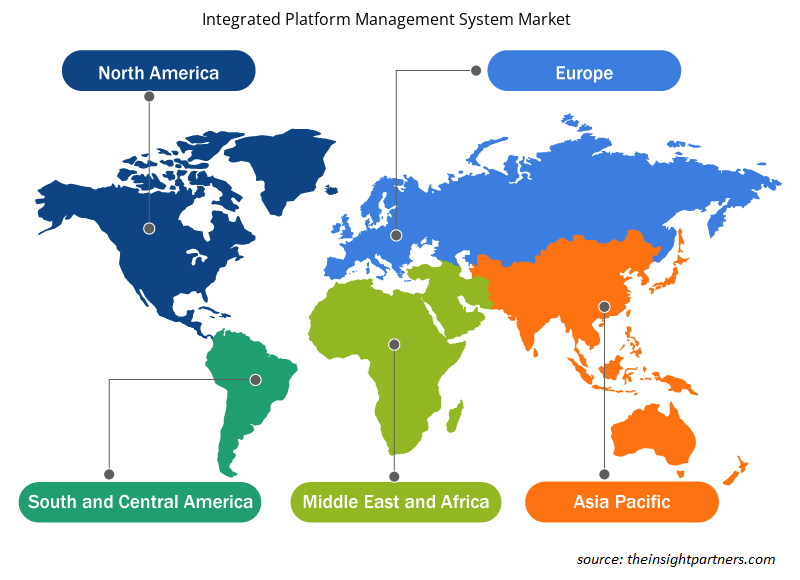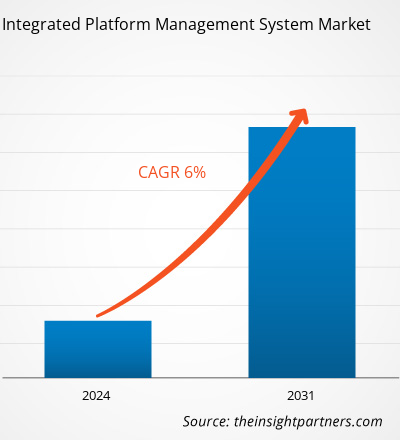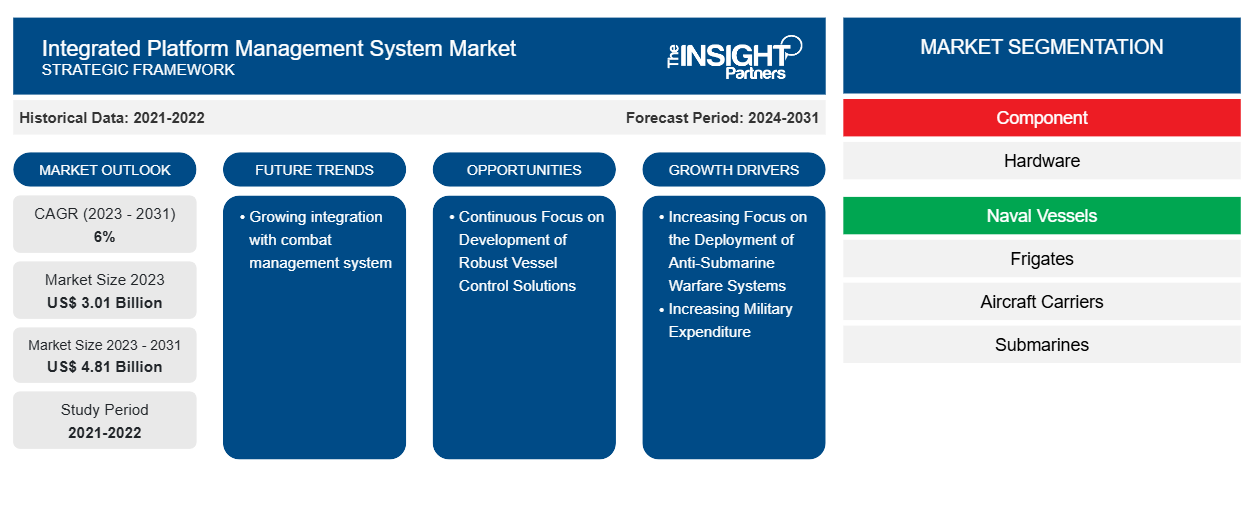Si prevede che la dimensione del mercato del sistema di gestione della piattaforma integrata raggiungerà i 4,81 miliardi di dollari entro il 2031, rispetto ai 3,01 miliardi di dollari del 2023. Si prevede che il mercato registrerà un CAGR del 6,0% nel periodo 2023-2031. Si prevede che la crescente integrazione con il sistema di gestione del combattimento guiderà il mercato e probabilmente rimarrà una tendenza chiave nel mercato.
Analisi di mercato del sistema di gestione della piattaforma integrata
Le forze navali in tutto il mondo stanno enfatizzando la guerra antisommergibile a causa dell'aumento delle minacce sottomarine. L'uso di veicoli sottomarini senza pilota (UUV) è in aumento; tuttavia, i sistemi di gestione della piattaforma integrati sono molto più efficienti nel rilevare e localizzare i sottomarini nemici. I sistemi di gestione della piattaforma integrati hanno anche il vantaggio di essere lanciati da navi da pattugliamento marittimo, il che riduce il rischio di danni collaterali. Per quanto riguarda questi fattori, la domanda di sistemi di gestione della piattaforma integrati è in aumento e, al fine di aumentare la forza della rispettiva ala di pattugliamento marittimo della marina con capacità migliorate, le forze navali stanno acquistando volumi maggiori di MPA dotati di sistemi di gestione della piattaforma integrati. La crescente domanda di sistemi di gestione della piattaforma integrati con un numero limitato di attori che operano nel mercato dei sistemi di gestione della piattaforma integrati sta mostrando un maggiore potere contrattuale degli acquirenti (produttori di imbarcazioni) nello scenario attuale. Tuttavia, si prevede che la domanda per gli stessi scenderà a un livello moderato in futuro con l'aumento del numero di attori del mercato dei sistemi di gestione della piattaforma integrati.
Panoramica del mercato del sistema di gestione della piattaforma integrata
La concorrenza nel mercato dei sistemi di gestione di piattaforme integrate è elevata a causa del fatto che i prodotti offerti dal produttore sono simili in termini di tecnologia. Inoltre, la presenza di operatori affermati come L3Harris Technologies Inc., ECA group, Boeing e Northrop Grumman Sperry Marine BV acquisisce la maggior parte dei contratti dai produttori di imbarcazioni e motovedette per la fornitura di sistemi di gestione di piattaforme integrate. Questi operatori competono tra loro su vari parametri come tipo di prodotto, tempi di consegna/prelievo, servizi post-vendita e numero di slot di distribuzione, tra gli altri. Pertanto, si prevede che la rivalità competitiva rimarrà elevata per tutto il periodo di previsione nel mercato dei sistemi di gestione di piattaforme integrate.
Personalizza questo report in base alle tue esigenze
Riceverai la personalizzazione gratuita di qualsiasi report, comprese parti di questo report, o analisi a livello nazionale, pacchetto dati Excel, oltre a usufruire di grandi offerte e sconti per start-up e università
-
Scopri le principali tendenze di mercato in questo rapporto.Questo campione GRATUITO includerà analisi di dati che spaziano dalle tendenze di mercato alle stime e alle previsioni.
Driver e opportunità di mercato del sistema di gestione della piattaforma integrata
Maggiore attenzione all'impiego di sistemi di guerra antisommergibile
Il crescente spiegamento di navi militari come fregate, corvette, sottomarini , pattugliatori e altre imbarcazioni/imbarcazioni è uno dei principali fattori che generano la domanda di spiegamento di sistemi di guerra antisommergibile in diverse regioni. Inoltre, ciò è anche supportato dall'elevata crescita dei sistemi di guerra navale in diverse regioni del mondo. Inoltre, la crescente tensione tra diversi paesi sta anche spingendo il governo di diversi paesi a investire grandi quantità di fondi nell'approvvigionamento di sistemi di guerra antisommergibile per diverse forze militari. Ad esempio:
- Damen Naval ha incaricato RENK di fornire otto unità di trasmissione per le nuove fregate Anti-Submarine Warfare (ASW). Il cantiere olandese sta costruendo quattro nuove fregate, due per la Royal Netherlands Navy e due per la Belgian Navy. (RENK, comunicato stampa, aprile 2024) Naval has commissioned RENK to supply eight gear units for the new Anti-Submarine Warfare (ASW) frigates. The Dutch yard is building four new frigates, two for the Royal Netherlands Navy and two for the Belgian Navy. (RENK, Press Release, Apr 2024)
- Kongsberg Maritime (KONGSBERG) fornirà quattro set di navi dei suoi sistemi di eliche a passo variabile e delle relative attrezzature, comprese le linee d'asse. È la seconda collaborazione tra Damen Naval e Kongsberg Maritime negli ultimi 18 mesi. (KONGSBERG, comunicato stampa, aprile 2024) Maritime (KONGSBERG) will supply four shipsets of its controllable pitch propeller systems and associated equipment, including shaftlines. It is the second collaboration between Damen Naval and Kongsberg Maritime in the past 18 months. (KONGSBERG, Press Release, Apr 2024)
- Modus Operandi, un'azienda che fornisce soluzioni di analisi Big Data per la sicurezza nazionale e le organizzazioni commerciali, si è aggiudicata un contratto da 1,5 milioni di dollari per sviluppare un sistema di guerra antisommergibile (ASW) per la Marina degli Stati Uniti. (Modus Operandi, comunicato stampa, 2023) Operandi, a company that delivers Big Data analytics solutions for national security and commercial organizations, has been awarded a $1.5 million contract to develop an Anti-Submarine Warfare (ASW) system for the U.S. Navy. (Modus Operandi, Press Release, 2023)
Tali fattori stanno spingendo la domanda di mercato di sistemi di gestione di piattaforme integrate in diverse regioni.
Attenzione continua allo sviluppo di soluzioni robuste per il controllo delle imbarcazioni
Le forze militari sono alla continua ricerca di soluzioni avanzate per le navi militari . Tra le principali tecnologie o sistemi, le truppe militari stanno tenendo d'occhio, i sistemi di gestione della piattaforma integrata sono uno dei sistemi cruciali. Ciò riguarda principalmente la domanda di modernizzazione delle forze con armamenti robusti e altri sistemi. A questo proposito, diverse forze militari stanno costringendo gli sviluppatori di tecnologia o sistemi, inclusi gli sviluppatori di sistemi di gestione della piattaforma integrata, a innovare e sviluppare soluzioni di controllo robuste. Si prevede che questo fattore creerà opportunità redditizie nel mercato dei sistemi di gestione della piattaforma integrata nei prossimi anni.
Analisi della segmentazione del rapporto di mercato del sistema di gestione della piattaforma integrata
I segmenti chiave che hanno contribuito alla derivazione dell'analisi di mercato del sistema di gestione della piattaforma integrata sono componenti, navi militari e applicazioni.
- In base al componente, il mercato del sistema di gestione della piattaforma integrata è segmentato in hardware e software. Il segmento hardware ha detenuto una quota di mercato maggiore nel 2023. Inoltre, il segmento hardware è stato sottosegmentato in sensori, attuatori, unità terminali remote, dispositivi di visualizzazione e altri.
- Basato sulle navi militari, il mercato dei sistemi di gestione delle piattaforme integrate è segmentato in fregate, portaerei e sottomarini. Il segmento dei sottomarini ha detenuto una quota di mercato maggiore nel 2023.
- In base all'applicazione, il mercato dei sistemi di gestione della piattaforma integrata è segmentato in controllo della propulsione, controllo dei macchinari ausiliari, sistemi di controllo di sicurezza e danni, monitoraggio di allarmi ed eventi e trainer di bordo. Il segmento dei sistemi di controllo di sicurezza e danni ha detenuto una quota di mercato maggiore nel 2023.
Analisi della quota di mercato del sistema di gestione della piattaforma integrata per area geografica
L'ambito geografico del rapporto di mercato sui sistemi di gestione della piattaforma integrata è suddiviso principalmente in cinque regioni: Nord America, Europa, Asia Pacifico, Medio Oriente e Africa e Sud America.
Il Nord America ha dominato il mercato nel 2023, seguito da Europa e regioni dell'Asia Pacifica. Inoltre, è probabile che l'Asia Pacifica assista al CAGR più elevato nei prossimi anni. Gli Stati Uniti hanno rappresentato la quota di mercato più grande nel mercato dei sistemi di gestione delle piattaforme integrate del Nord America nel 2023. Il paese detiene un numero elevato di sottomarini e portaerei che il suo territorio dovrebbe incrementare l'implementazione di IPMS nelle navi militari. La Marina degli Stati Uniti ha una superpotenza marittima in quanto ha navi da guerra pesantemente armate che aiutano a gestire il controllo del mare e la sicurezza marittima. Inoltre, il paese ha anche assistito a progetti relativi ai sottomarini che avranno un impatto anche sulla portata dei sistemi di gestione delle piattaforme integrate. Inoltre, le grandi condutture delle forze armate statunitensi per l'approvvigionamento di piattaforme navali sono un altro fattore importante che probabilmente genererà nuove opportunità per i fornitori del mercato dei sistemi di gestione delle piattaforme integrate nei prossimi anni.CAGR in the coming years. The US accounted for the largest market share in North America integrated platform management system market in 2023. The country holds strong number of submarines and aircraft carriers which its territory which is expected to boost the deployment of IPMS in naval vessels. The US Navy has a maritime superpower as it has heavily armed warship that helps in managing sea control and maritime security. In addition, the country also witnessed projects related to submarine that will also impact the scope of integrated platform managemet systems. Further, the large pipelines of the US armed forces for the procurement of naval platforms is another major factor likely to generate new opportunities for integrated platform management system market vendors in the coming years.
Approfondimenti regionali sul mercato del sistema di gestione della piattaforma integrata
Le tendenze regionali e i fattori che influenzano il mercato Integrated Platform Management System durante il periodo di previsione sono stati ampiamente spiegati dagli analisti di Insight Partners. Questa sezione discute anche i segmenti e la geografia del mercato Integrated Platform Management System in Nord America, Europa, Asia Pacifico, Medio Oriente e Africa e America meridionale e centrale.

- Ottieni i dati specifici regionali per il mercato del sistema di gestione della piattaforma integrata
Ambito del rapporto di mercato del sistema di gestione della piattaforma integrata
| Attributo del report | Dettagli |
|---|---|
| Dimensioni del mercato nel 2023 | 3,01 miliardi di dollari USA |
| Dimensioni del mercato entro il 2031 | 4,81 miliardi di dollari USA |
| CAGR globale (2023-2031) | 6% |
| Dati storici | 2021-2022 |
| Periodo di previsione | 2024-2031 |
| Segmenti coperti |
Per componente
|
| Regioni e Paesi coperti |
America del Nord
|
| Leader di mercato e profili aziendali chiave |
|
Densità degli attori del mercato: comprendere il suo impatto sulle dinamiche aziendali
Il mercato del mercato Integrated Platform Management System sta crescendo rapidamente, spinto dalla crescente domanda degli utenti finali dovuta a fattori quali l'evoluzione delle preferenze dei consumatori, i progressi tecnologici e una maggiore consapevolezza dei vantaggi del prodotto. Con l'aumento della domanda, le aziende stanno ampliando le loro offerte, innovando per soddisfare le esigenze dei consumatori e capitalizzando sulle tendenze emergenti, il che alimenta ulteriormente la crescita del mercato.
La densità degli operatori di mercato si riferisce alla distribuzione di aziende o società che operano in un particolare mercato o settore. Indica quanti concorrenti (operatori di mercato) sono presenti in un dato spazio di mercato in relazione alle sue dimensioni o al valore di mercato totale.
Le principali aziende che operano nel mercato dei sistemi di gestione della piattaforma integrata sono:
- Sistemi DB C2C
- Gruppo ECA
- L3HARRIES
- Larsen & Toubro Limited
- Logistico
- Northrop Grumman Sperry Marine BV
Disclaimer : le aziende elencate sopra non sono classificate secondo un ordine particolare.

- Ottieni la panoramica dei principali attori del mercato dei sistemi di gestione della piattaforma integrata
Notizie di mercato e sviluppi recenti del sistema di gestione della piattaforma integrata
Il mercato dei sistemi di gestione delle piattaforme integrate viene valutato raccogliendo dati qualitativi e quantitativi dopo la ricerca primaria e secondaria, che include importanti pubblicazioni aziendali, dati associativi e database. Di seguito sono elencati alcuni degli sviluppi nel mercato dei sistemi di gestione delle piattaforme integrate:
- Damen Naval ha firmato un contratto con RH Marine come primo fornitore olandese per le nuove fregate Anti-Submarine Warfare (ASW). RH Marine fornirà l'Integrated Mission Management System (IMMS), l'Integrated Navigation Bridge System (INBS) e l'Integrated Platform Management System (IPMS) per ciascuna delle quattro fregate per le marine olandese e belga. L'annuncio della cooperazione segue la firma ufficiale del contratto il 29 giugno tra il Ministero della Difesa olandese e Damen per la progettazione, la costruzione e la consegna delle nuove fregate. (Fonte: Damen Naval, comunicato stampa, giugno 2023)
- Northrop Grumman Corporation (NYSE: NOC) nel Regno Unito (NGUK) si è aggiudicata un contratto per il supporto in servizio del sistema di gestione della piattaforma sottomarina di classe Astute (PMS) da parte della Submarine Delivery Agency (SDA), un'agenzia esecutiva del Ministero della Difesa. (Fonte: Northrop Grumman Corporation, comunicato stampa, marzo 2022)
Copertura e risultati del rapporto di mercato sul sistema di gestione della piattaforma integrata
Il rapporto "Dimensioni e previsioni del mercato del sistema di gestione della piattaforma integrata (2021-2031)" fornisce un'analisi dettagliata del mercato che copre le seguenti aree:
- Dimensioni e previsioni del mercato del sistema di gestione della piattaforma integrata a livello globale, regionale e nazionale per tutti i segmenti di mercato chiave coperti dall'ambito
- Tendenze del mercato del sistema di gestione della piattaforma integrata e dinamiche di mercato come driver, vincoli e opportunità chiave
- Analisi dettagliata delle cinque forze di Porter
- Analisi di mercato del sistema di gestione della piattaforma integrata che copre le principali tendenze del mercato, il quadro globale e regionale, i principali attori, le normative e i recenti sviluppi del mercato
- Analisi del panorama industriale e della concorrenza che copre la concentrazione del mercato, l'analisi della mappa di calore, i principali attori e gli sviluppi recenti per il mercato dei sistemi di gestione della piattaforma integrata
- Profili aziendali dettagliati
- Analisi storica (2 anni), anno base, previsione (7 anni) con CAGR
- Analisi PEST e SWOT
- Valore/volume delle dimensioni del mercato - Globale, Regionale, Nazionale
- Industria e panorama competitivo
- Set di dati Excel
Report recenti
Rapporti correlati
Testimonianze
Motivo dell'acquisto
- Processo decisionale informato
- Comprensione delle dinamiche di mercato
- Analisi competitiva
- Analisi dei clienti
- Previsioni di mercato
- Mitigazione del rischio
- Pianificazione strategica
- Giustificazione degli investimenti
- Identificazione dei mercati emergenti
- Miglioramento delle strategie di marketing
- Aumento dell'efficienza operativa
- Allineamento alle tendenze normative























 Ottieni un campione gratuito per - Mercato dei sistemi di gestione della piattaforma integrata
Ottieni un campione gratuito per - Mercato dei sistemi di gestione della piattaforma integrata